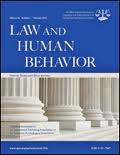 Gender plays a role in the association between the risk/need and protective factors on the SAVRY and risk of violence. This is the bottom line of a recently published article in Law and Human Behavior. Below is a summary of the research and findings as well as a translation of this research into practice.
Gender plays a role in the association between the risk/need and protective factors on the SAVRY and risk of violence. This is the bottom line of a recently published article in Law and Human Behavior. Below is a summary of the research and findings as well as a translation of this research into practice.
Featured Article| Law and Human Behavior | 2015, 1-15
Identifying Gender Specific Risk/Need Areas for Male and Female Juvenile Offenders: Factor Analyses with the Structured Assessment of Violence Risk in Youth (SAVRY)
Author
Ed. L. B. Hilterman, Tigburg University and Justa Mesura, Consultancy & Applied Research, Barcelona, Spain
Ilja Bongers, GGzE Center for Child and Adolescent Psychiatry, Netherlands, and Tigburg University
Tonia. L. Nicholls, University of British Columbia and Simon Frasier University
Chijs van Nieuwenhuizen, Tilburg University and GGzE Center tor Child & Adolescent Psychiatry, Eindhoven, The Netherlands
Abstract
By constructing risk assessment tools in which the individual items are organized in the same way for male and female juvenile offenders it is assumed that these items and subscales have similar relevance across males and females. The identification of criminogenic needs that vary in relevance for 1 of the genders, could contribute to more meaningful risk assessments, especially for female juvenile offenders. In this study, exploratory factor analyses (EFA) on a construction sample of male (n = 3,130) and female (n = 466) juvenile offenders were used to aggregate the 30 items of the Structured Assessment of Violence Risk in Youth (SAVRY) into empirically based risk/need factors and explore differences between genders. The factor models were cross-validated through confirmatory factor analyses (CFA) on a validation sample of male (n = 2,076) and female (n = 357) juvenile offenders. In both the construction sample and the validation sample, 5 factors were identified: (a) Antisocial behavior; (b) Family functioning; (c) Personality traits; (d) Social support; and (e) Treatability. The male and female models were significantly different and the internal consistency of the factors was good, both in the construction sample and the validation sample. Clustering risk/need items for male and female juvenile offenders into meaningful factors may guide clinicians in the identification of gender-specific treatment interventions.
Keywords
juvenile offenders, gender differences, factor analysis, risk management, violence risk assessment
Summary of the Research
“In recent decades research has demonstrated differences in risk factors between male and female juvenile offenders. For instance, risk factors related to family and social relationships have been found to be more important for female adolescents than for male adolescents (Cauffman, 2008; Fields & Abrams, 2010; Zahn et al., 2008). Compared with male juvenile offenders, female juvenile offenders also have a higher likelihood of exhibiting more mental health problems (Grande et al., 2012; Marston, Russell, Obsuth, & Watson, 2012). Further, according to Funk (1999), the presence of antisocial peers is more important for male juvenile offenders than for female adolescents. Factor analytic studies on risk assessment tools can provide information on differences in relevance of risk and protective factors between groups, for example genders. However, research on the psychometric structure of risk assessment tools for adolescents is scarce, especially regarding gender differences” (p.2).
Professionals in the Catalonian Justice Department in Catalonia, Spain were trained to administer the SAVRY to juveniles from 2006 until 2008. Interrater reliability for accuracy was excellent. Each assessment was given twice throughout the duration of the offenders stay in the juvenile sector. The following 5-factor model was assessed: antisocial behavior, family functioning, personality, social support, and treatability. Construction and validation samples were also used to support the 5-factor model.
“In the first step, we examined which factors could be found in the risk and protective items of the SAVRY that refer to gender specific risk/need areas. In the second step, the fit of the factor models for both male and female juvenile offenders was evaluated in validation samples and subsequently the difference between the models for both genders was measured. In the third step, we explored whether the found solutions could be accounted for by one underlying second-order construct. Finally, we analyzed the internal consistency of the different factors” (p.2).
Results
“The inclusion of Poor School Achievement and Community Disorganization in the Antisocial Behavior factor for female, but not for male offenders, suggests that female offenders have more acting out behavior in familiar environments like school or their neighborhood. This could be related to findings that female adolescents are more likely to be involved in relational or social aggression (Herrman & Silverstein, 2012; Miller, Winn, Taylor, & Wiki, 2012; Zahn et al., 2008; that may take place in familiar settings like school, the neighborhood, and the family) than in direct aggression, while males tend to be more involved in direct aggression toward strangers (Card, Stucky, Sawalani, & Little, 2008; Herrman & Silverstein, 2012; Skara et al., 2008; Zahn et al., 2008). The inclusion of the Community Disorganization item in the Antisocial Behavior factor could also indicate that violent and delinquent behavior among female adolescents was, compared with male juveniles, closer to their living environment (Kling, Ludwig, & Katz, 2005). Our results are consistent with research that indicates that female juvenile offenders benefit more, compared with male adolescents, from programs like “Move to Opportunity” in which their families are moved to safer neighborhoods (Clampet-Lundquist, Edin, Kling, & Duncan, 2011; Kling et al., 2005)” (p.10).
“For both males and females, Factor 2, Family Functioning, refers to a history of dysfunctional family relations. The inclusion, for female offenders, of current poor parental management in the Family Functioning factor also suggests that the association between a dysfunctional family history and poor supervision and harsh or inconsistent discipline by caregivers could be stronger for females than for males” (p.11).
The authors also found that female juvenile offenders with behavioral problems were associated with substance abuse and self-harm. Treatability and Social Support also differed based on gender wherein female mental health needs were mostly related to treatment compliance, but male treatment compliance was associated with the absence of protective factors.
Translating Research into Practice
“The clinical interpretation of the gender specific factors found in this study may also suggest different strategies to reduce recidivism risk for male and female juvenile offenders. This is a potentially promising development since there are indications that traditional treatment interventions designed on the basis of risk management tools for male juvenile offenders are less effective for female juvenile offenders (Miller, Leve, & Kerig, 2012; Vitopoulos et al., 2012). Based on these findings, it is recommended that risk assessment tools like the SAVRY provide specific information regarding gender specific effects of risk and protective factors. By doing so, it could be easier for assessors to decide which items are more relevant for female or male offenders, interpret gender specific differences, and adjust risk reduction strategies accordingly” (p.11)
“For a future version of SAVRY it would be important to consider the inclusion of additional protective factors (e.g., positive future orientation, positive relationships with parents and peers, and prosocial romantic relationships, which could be especially relevant for female offenders; Oudekerk & Reppucci, 2010) as a means of improving balanced assessment and treatment planning (see also de Vries Robbé et al., 2015; Viljoen et al., 2014). In addition, coding the protective items on a three-point scale, instead of dichotomously, would offer the advantage of more flexibility in scoring, which would make the tool more dynamic and more prone to measure change over time” (p.12).
“The separate risk/need assessment models for male and female juvenile offenders, and/or the inclusion of empirically based information on specific gender effects of risk and protective items may guide clinicians in the identification of gender-specific treatment needs; this is essential information to inform the debate regarding the necessity of gender-specific treatment interventions” (p.12).
As the authors have suggested, identifying gender differences on the SAVRY can aid professionals in understanding both the motivations behind juvenile criminal behavior and the resulting risk associated with violence. It can also be helpful in developing programs and treatments necessary to target gender specific risk needs and reduce recidivism.
Other Interesting Tidbits for Researchers and Clinicians
“Future research that evaluates field implementations by comparing and contrasting research-based SAVRY assessments and clinical SAVRY assessments (e.g., looking at agreement by different categories of assessors; testing predictive accuracy) would be able to address some of these gaps in knowledge. Second, the generalizability of the results to non-Spanish populations of juvenile offenders is limited and this study needs to be replicated in other cultural settings in, for instance, other European countries, North America and Latin America. Finally, although the sample contained a large proportion of immigrants (male: 43.2%; female: 20.8%), replication in ethnic and cultural minorities would be important to gain more insight into risk and protective factors important to diverse populations” (p.12)
Join the Discussion
As always, please join the discussion below if you have thoughts or comments to add!







